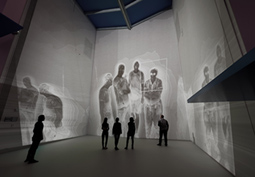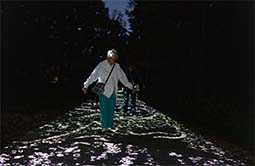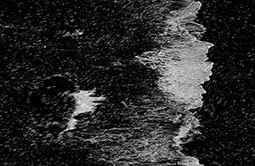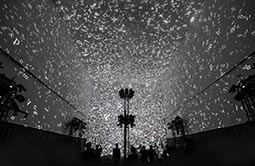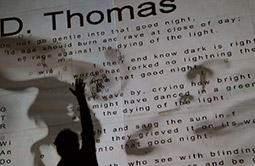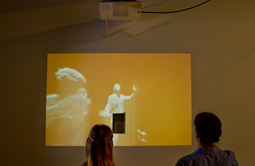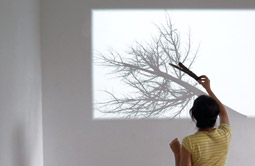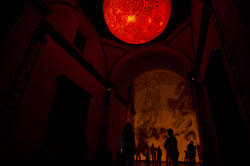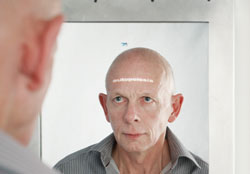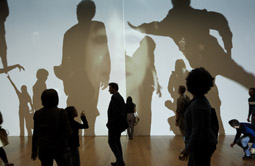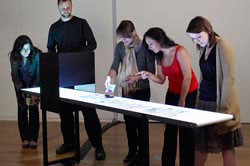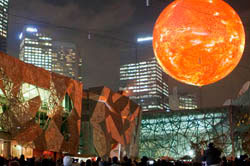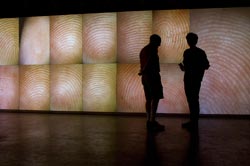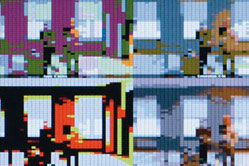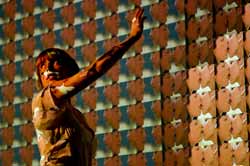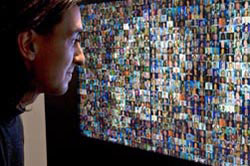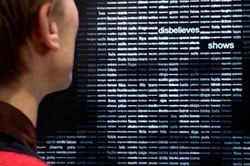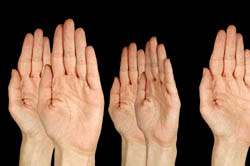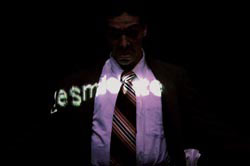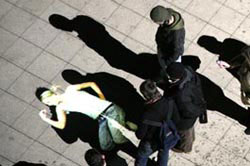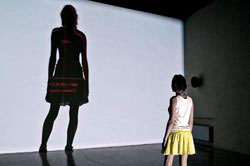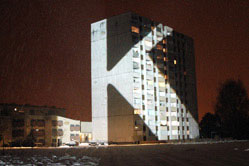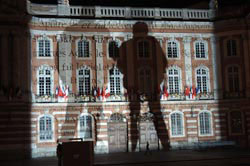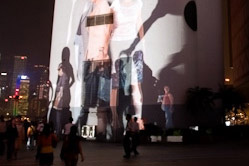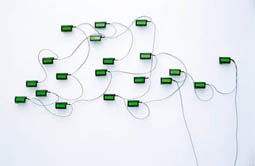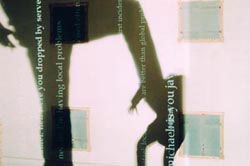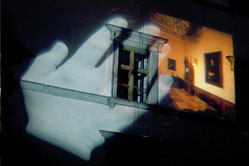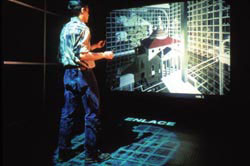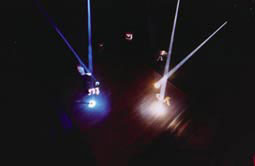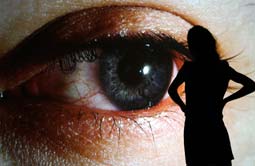Spectral Subjects
2024
“Spectral Subjects” is a thermal observatory that displays a constantly updating map of the room's temperature. Using thermographic cameras, the project detects heat and cold in the environment, including the building’s air circulation and ventilation, visitors’ body heat, and inanimate objects. As temperature is detected, the artwork creates a visible manifestation of the public’s “heat signature” in various ways, mixing live feeds with recently past heat signatures, materializing thermal echoes of the atmosphere, and creating an evolving portrait of uncanny spectral traces that make the atmosphere tangible. The artwork has two versions: a unique projection-based treatment that can be adapted to any architecture, and an edition that can be adapted to flatscreens of different sizes.
View details.
View details.
Arkansas Text Stream
Text Stream 9, 2022
“Arkansas Text Stream” (Text Stream 9) consists of brief texts sourced from Northwest Arkansas community members presented in a slow stream of letters that transform into phrases as the presence of people is detected. Commissioned by Crystal Bridges Museum of Art, Bentonville.
View details.
View details.
Hormonium
Text Stream 8, 2022
“Hormonium” (Text Stream 8) is a generative artwork that presents sequences of ocean waves crashing and releasing airborne text particles, with the text representing acronyms of hormones that are released in accordance with human time-cycles. This artwork is available as both a projection and a standalone piece.
View details.
View details.
Recurrent First Dream
Text Stream 10, 2022
“Recurrent First Dream” (Primero Sueño Recurrente) is a recursive algorithmic animation made with the collected works of Mexican poet Sor Juana Inés de la Cruz. An ascending vortex of words routinely appears and scans the displays, slowly revealing the poet’s mangum opus “First Dream”, a pioneering feminist ode to knowledge and deductive reasoning, written in 1692.
View details.
View details.
Encode/Decode
2020
"Encode/Decode," a generative interactive typographical environment made from the critical essay of Jamaican-British cultural studies scholar Stuart Hall (1932-2014) in which he proposes an encoding/decoding model of communication.
View details.
View details.
Babbage Lovelace
Text Stream 5, 2019
“Babbage Lovelace” (Text Stream 5) is a generative animation based on the collected texts of Charles Babbage and Ada Lovelace turned into a stream of letters.
View details.
View details.
Zoom Pavilion
2015
“Zoom Pavilion” is an interactive installation that consists of immersive projection on three walls, fed by 12 computerized surveillance systems trained on the public. The piece uses face recognition algorithms to detect the presence of participants and record their spatial relationship within the exhibition space. Independent robotic cameras zoom in to amplify the images of the public with up to 35x magnification: the zooming sequences are disorienting as they change the entire image "landscape" from easily recognizable wide shots of the crowd to abstract close-ups. Zoom Pavilion marks the first collaboration between artists Rafael Lozano-Hemmer and Krzysztof Wodiczko.
View details.
View details.
Airborne Newscasts
Relational Architecture 20, 2013
"Airborne Newscasts" (Relational Architecture 20) is an interactive installation originally commissioned by the Chrysler Museum of Art to transform Norfolk, Virginia’s public space into a poetic shadow play. By blocking the light of two projectors, participants cast their shadows onto a 900-square-metre wall, and these shadows are tracked by computerized surveillance systems. Out of the shadows emanate billowing smoke which is mapped onto the wall, slowly accumulating within it. Turbulent clouds of live newscasts evaporate from the “heat” of the tracked bodies.
View details.
View details.
First Surface
Shadow Object 3, 2012
“First Surface” (Shadow Object 3) is an artwork consisting of two front surface mirrors that are suspended from a thread and move with the air flow and with a small motor. Projected on the wall behind the mirrors is a real-time virtual representation of the public as seen from the perspective of the mirrors. The public is represented as patterned 3D silhouettes anchored in a reference prism that rotates with the mirrors. The piece is an attempt to construct an artificial perspective on the reflected subject.
View details.
View details.
Semioptics for Spinoza
Shadow Object 4, 2012
“Semioptics for Spinoza” (Shadow Object 4) is a plano-convex lens is suspended from a thread and moves with the airflow and with a small motor. Projected on the wall behind the lens is a set of artificial lens flares generated by equations that take into account the orientation of the lens in relation to the viewing public. The project generates fake light beams that go through the real lens: the lens then diffracts and scatters the fake light creating light source aberrations, directional haze and chromatic distortion.
View details.
View details.
Bifurcation
Shadow Object 2, 2012
“ Bifurcation” (Shadow Object 2) is small Y-shaped branch, similar to a divining rod, which is suspended from a thread and moves with the air flow and with a small motor. Projected on the wall behind the branch is its shadow, only you can see the entire tree from where the branch came. The branch and the tree shadow are always oriented in the same way.
View details.
View details.
Nave Solar
2011
“Nave Solar” is an interactive installation featuring a fake Sun that is activated by the pendular motion of the public as they hang from a rope and swing along the nave of a 16th Century catholic inquisition church. Using tracking systems, the installation detects the motion of participants and generates smoke that accumulates on the ceiling of the apse as well as activates the Sun's flares, surface turbulence and sun spots.
View details.
View details.
Sandbox
Relational Architecture 17, 2010
“Sandbox” (Relational Architecture 17) is a large-scale interactive installation created originally for Glow Santa Monica. The piece consists of two small sandboxes where one can see tiny projections of people who are at the beach. As participants reach out to touch these small ghosts, a camera detects their hands and relays them live to two of the world's brightest projectors, which hang from a boom lift and which project the hands over 8,000 square feet of beach. In this way people share three scales: the tiny sandbox images, the real human scale and the monstrous scale of special effects.
View details.
View details.
Autopoiesis
2010
When people look at themselves in this small mirror they see the word "Autopoiesis" projected on their forehead. The concept of self-creation described by Chilean biologists Maturana and Varela is an inspiration for all art that depends on participation to exist.
View details.
View details.
People on People
2010
“People on People” is an installation designed to displace the public’s image in real-time, creating a platform for embodiment and interpenetration. The piece consists of floor-mounted projectors that cast the shadow of the public onto a wall and another set of hanging projectors which project images inside the shadows.
View details.
View details.
Please Empty Your Pockets
Subsculpture 12, 2010
“Please Empty your Pockets” (Subsculpture 12) is an installation that consists of a conveyor belt with a scanner that records and accumulates everything that passes under it. The public may place any small object on the conveyor belt: once it passes under the scanner, the object reappears on the other side beside projected objects from the memory of the installation. As a real item is removed from the conveyor belt, it leaves behind a projected image of itself, which is then used to accompany future objects. The piece remembers up to 600,000 objects which are displayed beside new ones that are added to the installation.
View details.
View details.
Solar Equation
Relational Architecture 16, 2010
"Solar Equation" is a large-scale public art installation that consists of a faithful simulation of the Sun, 100 million times smaller than the real thing. Commissioned by the Light in Winter Festival in Melbourne, the piece features the world’s largest spherical balloon, custom-manufactured for the project, which is tethered over Federation Square and animated using five projectors. The solar animation on the balloon is generated by live mathematical equations that simulate the turbulence, flares and sunspots that can be seen on the surface of the Sun. This produces a constantly changing display that never repeats itself, giving viewers a glimpse of the majestic phenomena that are observable at the solar surface and that only relatively recent advances in astronomy have discovered. Using an iPhone, iPod touch or iPad, people may disturb the animations in real-time and select different fluid dynamic visualizations.
View details.
View details.
Pulse Index
2010
"Pulse Index" is an interactive installation that records participants’ fingerprints at the same time as their heart rates. The piece displays data for the last 765 and over participants in a stepped display that creates a horizon line of skin. As new recordings are added, the oldest ones disappear, —a kind of memento mori. To participate, people introduce their finger into a custom-made sensor equipped with a digital microscope and a heart rate sensor; their fingerprint immediately appears on the largest cell of the display, pulsating to their heart beat.
View details.
View details.
The Company of Colours
Shadow Box 9, 2009
"The Company of Colours" (Shadow Box 9) is the ninth piece in the Shadow Box series of interactive displays with a built-in computerized tracking system. This piece shows the live camera view constructed out of a palette of named colour swatches that can be rendered by computers. Every few minutes the piece automatically switches to show the live view made with a variety of culturally-significant colour palettes from computer and video game history, including the four shades of green of the original Nintendo Gameboy, the eight colours of teletext, and the 16 colours of the Commodore 64, the Apple II and the ZX Spectrum.
View details.
View details.
Make Out
Shadow Box 8, 2008
"Make Out" (Shadow Box 8) is an interactive piece showing thousands of internet videos of couples looking at each other. As soon as a participant stands in front of the display his or her silhouette is shown and all the couples within it begin to kiss. The massive array of make-out sessions continues for as long as someone is in front of the work—as he or she moves away all the kissing ends.
View details.
View details.
Reporters With Borders
Shadow Box 6, 2007
"Reporters With Borders" (Shadow Box 6) is a high-resolution interactive display that simultaneously shows 864 video clips of news anchors taken from TV broadcasts in the United States and Mexico. As the viewer stands in front of the piece his or her silhouette is shown on the display and within it reporters begin to talk. Every 5 minutes the piece switches the video clips - from a database of 1600 - and classifies them along gender, race and country, so that for instance on the left there are only American reporters and on the right only Mexicans.
View details.
View details.
Third Person
Shadow Box 2, 2006
"Third Person" (Shadow Box 2) is the second piece of the ShadowBox series of interactive displays with a built-in computerized tracking system. This piece shows the viewer's shadow revealing hundreds of tiny words that are in fact all the verbs of the dictionary conjugated in the third person. The portrait of the viewer is drawn in real time by active words, which appear automatically to fill his or her silhouette. The collector may choose to display the words in English, Spanish or French, or a combination of the three languages.
View details.
View details.
Glories of Accounting
Subsculpture 5, 2005
"Glories of Accounting" (Subsculpture 5) is an interactive installation with a surveillance system that detects the position of the public in the exhibition room. When someone walks into the room, large hands appear on the screen automatically. The hands rotate along their forearm axis, following the visitor with the open palms always facing them. As more viewers enter the room, more hands appear, each one following a member of the public.
View details.
View details.
Subtitled Public
2005
"Subtitled Public" consists of an empty exhibition space where visitors are detected by a computerised surveillance system. When people enter the space, the system generates a subtitle for each person and projects it onto him or her: the subtitle is chosen at random from a list of all the verbs conjugated in the third person. The only way of getting rid of a subtitle is to touch another person, which leads to the two subtitles being exchanged.
View details.
View details.
Under Scan
Relational Architecture 11, 2005
"Under Scan" (Relational Architecture 11) is a public art installation based on self-representation. Thousands of "video-portraits" taken in Derby, Leicester, Lincoln, Northampton and Nottingham are projected onto the ground; at first, the portraits are not visible because the space is flooded by white light coming from a high-powered projector. As people walk around the area, their shadows are cast on the ground, revealing the video-portraits in short sequences.
View details.
View details.
Frequency and Volume
Relational Architecture 9, 2003
"Frequency and Volume" (Relational Architecture 9) enables participants to tune into and listen to different radio frequencies by using their own bodies. A computerized tracking system detects participants' shadows, which are projected on a wall of the exhibition space. The shadows scan radio waves with their presence and position, while their size controls the volume of the signal. The piece can tune into any frequency between 150 kHz and 1.5 GHz, including air traffic control, FM, AM, short wave, cellular, CB, satellite, wireless telecommunication systems and radio navigation. Up to forty-eight frequencies can be tuned simultaneously and the resulting sound environment forms a composition controlled by people's movements.
View details.
View details.
1000 Platitudes
2003
"1000 Platitudes" is a large-scale photographic intervention project. It is comprised of photomontages and a video with 1,000 words or expressions commonly used to promote globalized cities to potential investors, such as "open", "modern", "clean", "multicultural" and "cosmopolitan". To make these images, a powerful projector (110,000 ANSI lumens of intensity for images of up to 70 by 70 metres) was placed on a 12-ton truck with a generator, then toured across the city of Linz, Austria.
View details.
View details.
Amodal Suspension
Relational Architecture 8, 2003
“Amodal Suspension" (Relational Architecture 8) is a large-scale interactive installation in which people send short text messages to each other using a cell phone or web browser. However, rather than being sent directly, the messages are encoded as unique sequences of flashes with twenty robotically-controlled searchlights, not unlike the patterns that make up Morse code. Messages "bounce" around from searchlight to searchlight, turning the sky into a giant switchboard.
View details.
View details.
Two Origins
Relational Architecture 7, 2002
“Two Origins” (Relational Architecture 7) is an intervention in which the emblematic Place du Capitole in Toulouse was transformed by a projection of The Book of Two Origins, a 13th-century heretical manuscript compiling the theological beliefs of the dualist cathars. Once a vibrant community in several regions of Europe, the believers in the two origins of the Universe were virtually annihilated by the brutal crusades that gave birth to the Inquisition and France's expansion. The texts are illegible since they are projected overlapping each other on the same façade from two distant projectors; only when passers-by block one text with their bodies is it possible to read the other text inside their shadow.
View details.
View details.
Body Movies
Relational Architecture 6, 2001
"Body Movies" transforms public space with interactive projections measuring between 400 and 1,800 square metres. Thousands of photographic portraits, previously taken on the streets of the host city, are shown using robotically controlled projectors. However the portraits only appear inside the projected shadows of the passersby, whose silhouettes can measure between two and twenty-five metres depending on how close or far away they are from the powerful light sources positioned on the ground.
View details.
View details.
33 Questions per Minute
Relational Architecture 5, 2000
"33 Questions Per Minute" (Relational Architecture 5) consists of a computer program which uses grammatical rules to combine words from a dictionary and generate 4.7 trillion unique, fortuitous questions. The automated questions are presented at a rate of 33 per minute—the threshold of legibility. The system will take over 271,000 years to ask all possible questions.
View details.
View details.
Re:Positioning Fear
Relational Architecture 3, 1997
"Re:Positioning Fear" (Relational Architecture 3) was a large-scale installation on the Landeszeughaus military arsenal with a "teleabsence" interface of projected shadows of passers-by. Using tracking systems, the shadows were automatically focused and generated sounds. A real-time IRC discussion about the transformation of the concept of "fear" was projected inside the shadows; the chat involved 30 artists and theorists from 17 countries.
View details.
View details.
Displaced Emperors
Relational Architecture 2, 1997
"Displaced Emperors" (Relational Architecture 2) was an interactive installation that used an "architact" —architecture meets haptics— interface to transform the facade of the Habsburg Castle in Linz, Austria. Wireless 3D sensors calculated where participants pointed to on the façade and a large animated projection of a hand was projected at that location. As people on the street "caressed" the building, they could reveal the interiors of the Habsburg residence in Mexico City, Castillo de Chapultepec.
View details.
View details.
The Able Skin
1997
"The Able Skin" is a media structure designed by architect Emilio López-Galiacho to hide any emblematic building that is not allowed to have a natural death, that is kept alive artificially through restoration, citation and simulation. A virtual reality installation allows participants to tour the first Able Skin, which covers Palladios Villa Rotonda. The participant's motion controls the point of view in the projected environments on the wall and the floor.
View details.
View details.
The Trace
1995
"The Trace" is a telepresence installation that invites two participants in remote sites to share the same telematic space. The piece consists of light vectors, sounds and graphics that respond to the movement of the participants. Two interactive stations are needed for the piece; these are interconnected with a normal ISDN digital line so they can be in the same exhibition hall, on either side of a city or in different cities.
View details.
View details.
Surface Tension
1992
"Surface Tension" is an interactive installation where an image of a giant human eye follows the observer with orwellian precision.This work was inspired by a reading of Georges Bataille's text The Solar Anus during the first Gulf War: first wide-spread deployment of camera-guided "intelligent bombs". Present-day computerised surveillance techniques employed by the Department of Homeland Security in the United States through the Patriot Act, provide a new and distressing backdrop for this piece.
View details.
View details.
